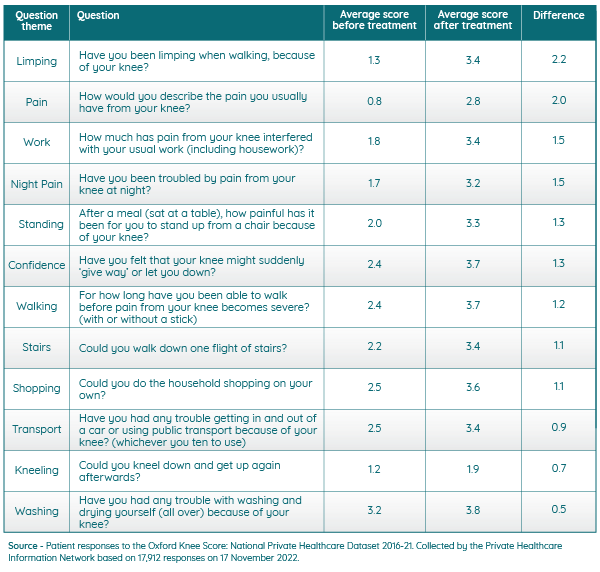The various parts of the healthcare sector all have different objectives and requirements, but one issue that should be at the heart of everyone’s work is patient health, and making interventions that improve it. How do we tell how successfully we are making that happen?
Patient Reported Outcomes Measures (PROMs) are a key opportunity to measure and report on patient health from the people who go through the treatment, the patients. We take a look at the benefits of PROMs for patients, clinicians and hospitals and share insights into how the data we collect paints a picture of patients’ journeys.
This article was written for, and first published in, Healthcare Markets magazine.
What are PROMs?
PROMs are structured questionnaires given to patients who are having surgery, or any type of health intervention, designed to promote an improvement. They’re also called health improvement measures.
The questions focus on different aspects of health, pain, functional ability and overall quality of life. Some PROMs are generic, others are very specific to a condition or procedure, such as heart surgery.
We can look at responses to see how a patient compares with people having the same treatment, both beforehand and afterwards, and see – on a like-for-like basis – what has worked well or not improved for them.
PROMs provide many benefits, a small selection of which are discussed below:
Benefits for patients
Before treatment, PROMs can act as a useful structure for patients to discuss aspects of treatment and recovery with their consultant. They also allow patients to see what good quality care and treatment effectiveness actually looks like and set appropriate goals. They can see factors which impact on outcomes and better understand the reasons for following the recommended treatment plan.
Then after their treatment, patients are able to track their own progress versus expectations, and see how they compare with people like them. Crucially, using PROMs can also help patients to spot any danger signals earlier, and speed up their own return to care if necessary.
Benefits for clinicians
Using PROMs pre-treatment helps the clinician to see whether patients are within relevant norms for treatment, and provides them with evidence that this is the right time to intervene. Using PROMs can also help to manage patients’ expectations about practical and emotional aspects of recovery and any consequences. They can be used to define what great care looks like alongside realistic outcomes for this patient, focusing on what matters most to them individually.
Following treatment, clinicians can measure patient progress towards treatment goals, adjusting care process based on reported PROMs. They can use the evidence to analyse and see any patterns of effectiveness which facilitate quality improvement.
Another important benefit is that PROMS materials can be used for both appraisals and the promotion of services – confirming excellent service levels and treatment effectiveness.
Benefits for hospitals
The win-win situation continues where hospitals are concerned too. Using PROMs means hospitals can provide tangible evidence of success to patients and commissioners, and identify opportunities for service efficiencies. For instance, could an additional night in hospital confer longer-term health gains for patient, everything else being equal?
The insights that can be extracted from PROMs can be used to support clinicians’ appraisals and ultimately improve clinical practice. They should be viewed as part of good clinical governance and professional standards.
What is the private sector doing on PROMs?
The private sector has been collecting PROMs for over 20 years. Over 140 private hospitals and clinics now regularly share data with PHIN for a range of surgical procedures and cosmetic treatments. This is all now feeds into the wider reporting designed to inform consumers about treatments and choice in private healthcare driven by the Competition and Market Authority.
An independent piece of research carried out by the London School of Economics in 2021 made several recommendations including:
- Bringing the PROMs up to date
- Promoting greater collaboration across the whole private sector
- Encouraging participation in PROMs where applicable as part of routine care and as part of a cultural shift to gathering evidence, reflecting on it and making improvements
- Delivering value to all participants
A PROMs working group – composed of private hospitals, professional bodies, insurers, PROMs system suppliers and PHIN – meets regularly to deliver these and other recommendations.
What are the insights? A focus on knees
At a whole-population level, there is overall a very good picture of improvement following knee surgery – which is why this is one of the most popular procedures. We have feedback from over 17,000 patients, which gives us confidence that the results are valid and representative. The survey used is the Oxford Knee Score, which has 12 dimensions which each have a scale from 0 (worst possible) to 4 (best possible).
- The greatest proportion of people having knee replacements and completing these PROMs are in their 70s, followed by those in their 60s.
- Women tend to have slightly worse scores before treatment, but see similar overall improvements as men.
- Those improvements do not significantly vary by decade, though those in their 90s on average reach a slightly lower end score.
- People receiving knee replacements see big improvements by not limping so much, and other areas such as pain, standing and confidence all each see good improvements too.
- Kneeling, if anything, is the biggest problem after treatment, regardless of gender or age. It can be reassuring to know that others like you are experiencing something similar and that this is normal: it’s not that your procedure has gone ‘wrong.’
This data is not case-mix adjusted, that’s to say adjusted for the fact that each individual has a different health profile. However, the large sample size should even out the extremes of variation and should be reliable at a summary level.

Other PROMs that we capture – headline insights
1. Hip replacements: For all the PROMs that we report, this surgical procedure shows the most consistent levels of improvement across all dimensions. The most prominent of these is the reduction of the need to limp – on a scale of 0 to 4, this shows an average change of +2.7 points, based on feedback over 22,000 patients.
2. Cataracts: Satisfaction with eyesight shows the greatest improvement based on over 10,000 patients.
3. Shoulders: Considering evidence from over 800 patients, the reduction of night pain is the aspect of shoulder treatment which most changes for patients as a result of this replacement procedure.
4. Carpal tunnel: One of the most significant issues for patients receiving this treatment is the experience of tingling in their hands. Fortunately, the evidence from over 600 patients is that this shows the greatest improvement (or reduction) as a result of treatment.
PROMs for all, and all for PROMs
The insights we gain from PROMs have wide benefits for all involved and we’re looking to expand the range of procedures covered so that there is an even clearer picture of a patient’s journey through treatment and beyond. We'd be happy to talk to anyone who’s keen to learn more.
